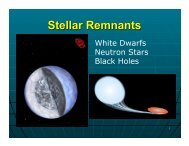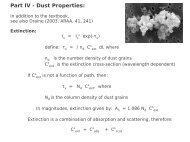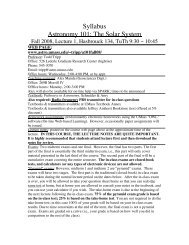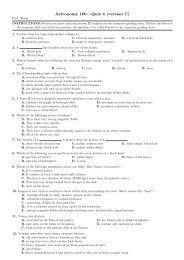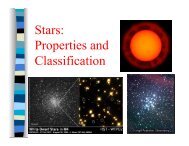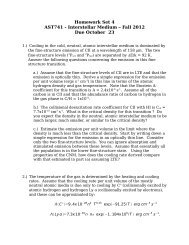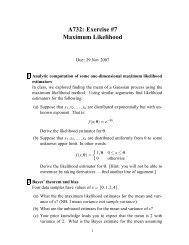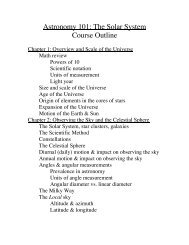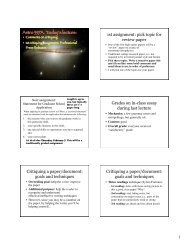Homework 6 - UMass Astronomy
Homework 6 - UMass Astronomy
Homework 6 - UMass Astronomy
You also want an ePaper? Increase the reach of your titles
YUMPU automatically turns print PDFs into web optimized ePapers that Google loves.
<strong>Homework</strong> 6<br />
<strong>Astronomy</strong> 228 – Spring 2012<br />
Due: Class Time on Thursday, March 29<br />
Answer the following questions. Be certain to show all of your work for full<br />
credit. Each question is worth 10 points.<br />
Question 1: Any mass object can become a black hole if it is sufficiently<br />
collapsed so to be smaller than its Schwarzschild radius. What is the<br />
Schwarzschild radius for an object with the mass of the Earth ?<br />
Question 2: Pulsars are rapidly rotating collapsed objects. Consider a 1<br />
solar mass white dwarf star with a radius of 5000 km. To explain the light<br />
variations of pulsars, a white dwarf would need to rotate at a rate of at least<br />
1 revolution per second. For the white dwarf star compute the gravitational<br />
acceleration and the centripetal acceleration at the surface on the equator.<br />
Compare these two accelerations, do you think white dwarf stars can spin<br />
that rapidly ?<br />
Question 3: Hopefully you found in Question 2 that white dwarf stars<br />
cannot be pulsars. Now consider a 2 solar mass neutron star with a radius<br />
of 10 km. Again to explain the light variations of pulsars, this neutron stars<br />
would need to rotate at a rate of at least 1 revolution per second. For the<br />
neutron star compute the gravitational acceleration and the centripetal<br />
acceleration at the surface on the equator. Compare the the two<br />
accelerations. Is it possible for neutron stars to rotate this rapidly ?<br />
Question 4: Consider a 2 solar mass neutron star with a radius of 10 km.<br />
What is the escape speed from its surface ? How does this compare with the<br />
speed of light ?<br />
Question 5: For the neutron star in Question 4, compute the mean<br />
separation between neutrons. How does this compare with the “size” of a<br />
neutron of about 1x10 -13 cm ?<br />
Questions 6: A Type Ia supernova produces about 1x10 51 ergs of energy in<br />
the thermonuclear explosion. Compare this energy with an estimate of the<br />
total amount of energy that the Sun produces over its main sequence<br />
lifetime.
Questions 7: A Type Ia supernova at its peak in brightness has an absolute<br />
visual magnitude of -19.3. With our modern day telescopes and detectors,<br />
we can detect astronomical objects with apparent visual magnitudes of +28.<br />
How far away can we see detect a Type Ia supernova (you might want to<br />
express your answer in Mpc or millions of parsecs) ?<br />
Questions 8: Cyg X-1 is a bright X-ray emitting binary system believed to<br />
be composed of a 25 solar mass O-type supergiant (O Iab) star and a 9 solar<br />
mass black hole. The orbital period is 5.6 days. Assuming circular orbits,<br />
compute the separation between the two stars. The inner Lagrangian point<br />
(L1) lies between the two objects (assume this is the point where the<br />
gravitational force of the A-type supergiant star and the black hole on an<br />
object is equal). How far is the L1 point from the center of the O-type<br />
supergiant star ?<br />
Question 9: The O-type supergiant star in the Cyg X-1 system has a<br />
luminosity of 4x10 5 solar luminosities (1.6x10 39 ergs s -1 ) and a surface<br />
temperature of 28,000 K. Compute the radius of the O-type supergiant star.<br />
Using the result from question 8, is it plausible that matter from the A-type<br />
supergiant is spilling onto the black hole ?<br />
Question 10: Figure 13.11 in the textbook shows a composite H-R diagram<br />
for globular clusters in the Milky Way. Use the information given in<br />
Appendix E and what we know about the main sequence lifetime of stars to<br />
estimate the age of this composite star cluster. Explain your answer.



